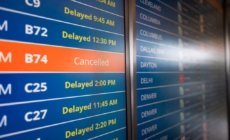-
Dodgers’ Mookie Betts Sends Harsh Red Sox Message On Infamous Trade - 22 mins ago
-
As Trump Tours Asia, Democracy’s Ideals Aren’t on the Agenda - 33 mins ago
-
Gavin Newsom’s odds of becoming president in 2028 - 57 mins ago
-
Is A.I. a Bubble? - about 1 hour ago
-
Daniel Naroditsky cause of death: What we know after chess star dies at 29 - 2 hours ago
-
The motives behind Frank McCourt’s Dodger Stadium gondola plan - 2 hours ago
-
Food Banks Brace for Growing Demand, and Putin’s New Missile Test - 2 hours ago
-
Flight Status Tracker: Thousands of Journeys Delayed Nationwide - 2 hours ago
-
Trump, contradicting California GOP, opposes early voting on Prop. 50 - 3 hours ago
-
Dog Waits 532 Days in Shelter, Then Comes Happy Ending - 3 hours ago
US Warship Arrives on Venezuela’s Doorstep
A U.S. Navy destroyer equipped with guided missiles, helicopters, and U.S. Marines has arrived in Trinidad and Tobago—just miles from Venezuela’s coast—triggering a furious response from Caracas on Monday.
The USS Gravely, an Arleigh Burke-class warship, docked in Port of Spain on Sunday to take part in joint exercises with Trinidad and Tobago’s defense forces, according to U.S. officials.
Venezuelan officials immediately denounced the move, calling it a threat to regional stability. Executive Vice President Delcy Rodríguez accused the U.S. and its Caribbean ally of staging “a military provocation” near Venezuelan territorial waters, warning it risked igniting a broader conflict in the region.
Newsweek has reached out to the State Department and the Venezuelan Foreign Ministry for comment.
Why It Matters
The USS Gravely’s arrival is part of a broader U.S. military buildup in the Caribbean as President Donald Trump ramps up pressure on Venezuelan President Nicolás Maduro. Alongside the destroyer, the aircraft carrier USS Gerald R. Ford and its strike group—including cruisers, destroyers, surveillance and electronic warfare aircraft, and support vessels—have moved closer to Venezuelan waters, representing the largest U.S. presence in the region in decades.
Washington says the deployment targets illicit trafficking and regional security threats, but Caracas sees it as preparation for military intervention. The standoff highlights escalating tensions between the two nations and carries global implications: Venezuela’s vast oil reserves and alliances with Russia, China, and Iran make the region a potential flash point in a broader geopolitical struggle.

What to Know
“Venezuela denounces the military provocation of Trinidad and Tobago, in coordination with the CIA, aimed at provoking a war in the Caribbean,” Rodríguez declared on her Telegram channel. She went on to condemn Trinidad and Tobago for acting as a “vassal nation” and “military colony” serving U.S. interests in Latin America.
Government officials in Port of Spain said the warship will remain in Trinidad until Thursday for training exercises.
Mission and Capabilities
The USS Gravely is a 9,000-ton guided missile destroyer armed with Tomahawk cruise missiles, anti-aircraft defense systems, and advanced radar. The warship carries Marines and helicopters capable of rapid deployment, underscoring its dual purpose as a deterrent and quick-response vessel.
Pentagon’s Official Justification
According to the Pentagon, the deployment falls under U.S. Southern Command’s broader operations to “detect, monitor, and interdict illicit activities that threaten the security and prosperity of the United States.” The Gravely’s presence accompanies the USS Ford carrier strike group, which was deployed to the Caribbean last week carrying fighter jets, electronic warfare aircraft, and surveillance planes.
Escalation of U.S. Operations
Since late August, the Caribbean has seen an unprecedented buildup of U.S. military forces near Venezuela. More than 10,000 troops and dozens of fighter jets have been stationed across the region. Many of the personnel are aboard eight warships, while the remainder are based in Puerto Rico, about 800 kilometers from Venezuela’s coast.
The Trump administration, which has repeatedly accused Maduro of leading a drug cartel, says the deployment is aimed at combating drug trafficking to the U.S.
American forces have intensified strikes on suspected trafficking vessels in the Caribbean and Pacific, targeting at least 10 boats and reportedly killing 43 people since September.
Despite Washington’s stated goal, the growing military presence has fueled speculation that the administration is preparing to remove Maduro from power, heightening tensions in the region.

What People Are Saying
Venezuelan Executive Vice President Delcy Rodríguez: “Venezuela denounces the military provocation of Trinidad and Tobago, in coordination with the CIA, aimed at provoking a war in the Caribbean.”
Secretary of State Marco Rubio: “We have deployed U.S. assets and interests all over the planet, but when we do it in our own hemisphere, which is logically where you probably spend most of your time and energy because it’s the hemisphere you live in, everyone sort of freaks out.”
What Happens Next
Venezuela’s diplomatic protest has heightened scrutiny as the U.S. military buildup continues near its maritime borders. Caracas warns that the growing American presence could trigger one of the most serious geopolitical confrontations in the Caribbean since the Cold War.
The standoff risks testing regional alliances, drawing the attention of global powers, and increasing the possibility of accidental clashes at sea or in nearby airspace. The situation remains tense, with both sides signaling a readiness to escalate if their strategic objectives are challenged.
Source link





















